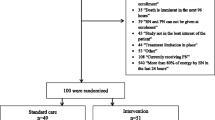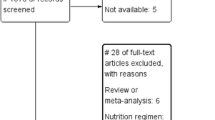Abstract
Purpose
We assessed the effects of early goal-directed nutrition (EGDN) vs. standard nutritional care in adult intensive care unit (ICU) patients.
Methods
We randomised acutely admitted, mechanically ventilated ICU patients expected to stay longer than 3 days in the ICU. In the EGDN group we estimated nutritional requirements by indirect calorimetry and 24-h urinary urea aiming at covering 100% of requirements from the first full trial day using enteral and parenteral nutrition. In the standard of care group we aimed at providing 25 kcal/kg/day by enteral nutrition. If this was not met by day 7, patients were supplemented with parenteral nutrition. The primary outcome was physical component summary (PCS) score of SF-36 at 6 months. We performed multiple imputation for data of the non-responders.
Results
We randomised 203 patients and included 199 in the intention-to-treat analyses; baseline variables were reasonably balanced between the two groups. The EGDN group had less negative energy (p < 0.001) and protein (p < 0.001) balances in the ICU as compared to the standard of care group. The PCS score at 6 months did not differ between the two groups (mean difference 0.0, 95% CI −5.9 to 5.8, p = 0.99); neither did mortality, rates of organ failures, serious adverse reactions or infections in the ICU, length of ICU or hospital stay, or days alive without life support at 90 days.
Conclusions
EGDN did not appear to affect physical quality of life at 6 months or other important outcomes as compared to standard nutrition care in acutely admitted, mechanically ventilated, adult ICU patients.
Clinicaltrials.gov identifier no. NCT01372176.



Similar content being viewed by others
References
Van den Berghe G (2017) The 2016 ESPEN Sir David Cuthbertson lecture: interfering with neuroendocrine and metabolic responses to critical illness: From acute to long-term consequences. Clin Nutr 36:348–354
Casaer MP, Mesotten D, Hermans G et al (2011) Early versus late parenteral nutrition in critically ill adults. N Engl J Med 365:506–517
Harvey SE, Parrott F, Harrison DA et al (2014) Trial of the route of early nutritional support in critically ill adults. N Engl J Med 371(18):1673–1684
Singer P, Anbar R, Cohen J et al (2011) The tight calorie control study (TICACOS): a prospective, randomized, controlled pilot study of nutritional support in critically ill patients. Intensive Care Med 37:601–609
Heidegger CP, Berger MM, Graf S et al (2013) Optimisation of energy provision with supplemental parenteral nutrition in critically ill patients: a randomised controlled clinical trial. Lancet 381:385–393
Doig GS, Simpson F, Sweetman EA et al (2013) Early parenteral nutrition in critically ill patients with short-term relative contraindications to early enteral nutrition: a randomized controlled trial. JAMA 309:2130–2138
Arabi YM, Casaer MP, Chapman M et al (2017) The intensive care medicine research agenda in nutrition and metabolism. Intensive Care Med. doi:10.1007/s00134-017-4711-6.
Kreymann KG, Berger MM, Deutz NEP et al (2006) ESPEN guidelines on enteral nutrition: intensive care. Clin Nutr 25:210–223
Singer P, Berger MM, van den Berghe G et al (2009) ESPEN guidelines on parenteral nutrition: intensive care. Clin Nutr 28:387–400
Dhaliwal R, Cahill N, Lemieux M, Heyland DK (2014) The Canadian critical care nutrition guidelines in 2013: an update on current recommendations and implementation strategies. Nutr Clin Pract 29:29–43
Reintam Blaser A, Starkopf J, Alhazzani W et al (2017) Early enteral nutrition in critically ill patients: ESICM clinical practice guidelines. Intensive Care Med 43:380–398
McClave SA, Taylor BE, Martindale RG et al (2016) Guidelines for the provision and assessment of nutrition support therapy in the adult critically ill patient: Society of Critical Care Medicine (SCCM) and American Society for Parenteral and Enteral Nutrition (A.S.P.E.N.). JPEN J Parenter Enter Nutr 40:159–211
Weijs PJM, Stapel SN, de Groot SDW et al (2012) Optimal protein and energy nutrition decreases mortality in mechanically ventilated, critically ill patients: a prospective observational cohort study. JPEN J Parenter Enteral Nutr 36:60–68
Elke G, Wang M, Weiler N et al (2014) Close to recommended caloric and protein intake by enteral nutrition is associated with better clinical outcome of critically ill septic patients: secondary analysis of a large international nutrition database. Crit Care 18:R29
Oshima T, Deutz NE, Doig G et al (2015) Protein-energy nutrition in the ICU is the power couple: a hypothesis forming analysis. Clin Nutr 35:968–974
Blackburn GL, Bistrian BR, Maini BS et al (1977) Nutritional and metabolic assessment of the hospitalized putient. JPEN J Parenter Enter Nutr 1:11–22
Mellin-Olsen J, Staender S, Whitaker DK, Smith AF (2010) The Helsinki declaration on patient safety in anaesthesiology. Eur J Anaesthesiol 27:592–597
Allingstrup MJ, Kondrup J, Wiis J et al (2016) Early goal-directed nutrition in ICU patients (EAT-ICU): protocol for a randomised trial. Dan Med J 63:1–6
Moher D, Hopewell S, Schulz KF et al (2012) CONSORT 2010 explanation and elaboration: updated guidelines for reporting parallel group randomised trials. Int J Surg 10:28–55
Perner A, Haase N, Guttormsen AB et al (2012) Hydroxyethyl starch 130/0.42 versus Ringer’s acetate in severe sepsis. N Engl J Med 367:124–134
Doig GS, Simpson F (2005) Randomization and allocation concealment: a practical guide for researchers. J Crit Care 20:187–191
Martindale RG, McClave SA, Vanek VW et al (2009) Guidelines for the provision and assessment of nutrition support therapy in the adult critically ill patient: Society of Critical Care Medicine (SCCM) and American Society for Parenteral and Enteral Nutrition (A.S.P.E.N.). JPEN J Parenter Enteral Nutr 37:1757–1761
Finfer S, Chittock DR, Su SY et al (2009) Intensive versus conventional glucose control in critically ill patients. N Engl J Med 360:1283–1297
Wiener RS, Wiener DC, Larson RJ (2008) Benefits and risks of tight glucose control in critically ill adults: a meta-analysis. JAMA 300:933–944
Ware JE Jr, Sherbourne CD (1992) The MOS 36-item short-form health survey (SF-36). I. Conceptual framework and item selection. Med Care 30:473–483
Chrispin PS, Scotton H, Rogers J et al (1997) Short Form 36 in the intensive care unit: assessment of acceptability, reliability and validity of the questionnaire. Anaesthesia 52:15–23
Vincent JL, Moreno R, Takala J et al (1996) The SOFA (sepsis-related organ failure assessment) score to describe organ dysfunction/failure. Intensive Care Med 22:707–710
Calandra T, Cohen J (2005) The International Sepsis Forum consensus conference on definitions of infection in the intensive care unit. Crit Care Med 33:1538–1548
Schrøder MA, Poulsen JB, Perner A (2011) Acceptable long-term outcome in elderly intensive care unit patients. Dan Med Bull 58:A4297
Fergusson D, Aaron SD, Guyatt G, Hébert P (2002) Post-randomisation exclusions: the intention to treat principle and excluding patients from analysis. BMJ 325:652–654
Schafer JL, Graham JW (2002) Missing data: our view of the state of the art. Psychol Methods 7:147–177
Compher C, Frankenfield D, Keim N, Roth-Yousey L (2006) Best practice methods to apply to measurement of resting metabolic rate in adults: a systematic review. J Am Diet Assoc 106:881–903
Sundström M, Tjäder I, Rooyackers O, Wernerman J (2013) Indirect calorimetry in mechanically ventilated patients. A systematic comparison of three instruments. Clin Nutr 32:118–121
Graf S, Karsegard VL, Viatte V et al (2014) Evaluation of three indirect calorimetry devices in mechanically ventilated patients: which device compares best with the Deltatrac II(®)? A prospective observational study. Clin Nutr 34:60–65
Allingstrup MJ, Kondrup J, Perner A et al (2016) Indirect calorimetry in mechanically ventilated patients: a prospective, randomized, clinical validation of 2 devices against a gold standard. JPEN J Parenter Enteral Nutr. doi:10.1177/0148607116662000
Marik PE, Hooper MH (2015) Normocaloric versus hypocaloric feeding on the outcomes of ICU patients: a systematic review and meta-analysis. Intensive Care Med 42(3):316–323
Elke G, van Zanten ARH, Lemieux M et al (2016) Enteral versus parenteral nutrition in critically ill patients: an updated systematic review and meta-analysis of randomized controlled trials. Crit Care 20:117
Allingstrup MJ, Esmailzadeh N, Wilkens Knudsen A et al (2012) Provision of protein and energy in relation to measured requirements in intensive care patients. Clin Nutr 31:462–468
Hoffer LJ, Bistrian BR (2012) Appropriate protein provision in critical illness: a systematic and narrative review. Am J Clin Nutr 96:591–600
Alberda C, Gramlich L, Jones N et al (2009) The relationship between nutritional intake and clinical outcomes in critically ill patients: results of an international multicenter observational study. Intensive Care Med 35:1728–1737
Acknowledgements
We warmly thank past and present employees at the Department of Intensive Care 4131, Copenhagen University Hospital, Rigshospitalet for good spirits and positive collaboration during the trial period. The research nurses, Jette Degn and Vibeke Knudsen in particular, have made a huge difference during this project. We also thank Sofie L. Rygaard, Maj-Brit N. Kjær, Peter B. Hjortrup and Rasmus B. Müller for their help, and Gordon S. Doig for his invaluable input during the statistical analyses.
Author information
Authors and Affiliations
Contributions
MJA, JW, JK and AP designed the study. MJA, JW, CC, UGP, RHR, MS, THJ, MRB and MHM collected the data. MJA and AP analysed the data and TL and MBM assisted with statistical analyses. MJA, AP and JK planned the article and MJA produced a detailed outline of the manuscript. All authors reviewed the article critically, contributed significantly and approved the final manuscript.
Corresponding author
Ethics declarations
Conflicts of interest
The trial was funded by Rigshospitalet and supported by Fresenius Kabi, The European Society for Clinical Nutrition and Metabolism (ESPEN), COSMED and Medinor/MedGraphics. The funders had no roles in designing or executing the trial, in analyses of the data, in writing of the manuscript or in the decision to publish. The Department of Intensive Care, Rigshospitalet receives support for research from CSL Behring and Ferring Pharmaceuticals.
Electronic supplementary material
Below is the link to the electronic supplementary material.
Rights and permissions
About this article
Cite this article
Allingstrup, M.J., Kondrup, J., Wiis, J. et al. Early goal-directed nutrition versus standard of care in adult intensive care patients: the single-centre, randomised, outcome assessor-blinded EAT-ICU trial. Intensive Care Med 43, 1637–1647 (2017). https://doi.org/10.1007/s00134-017-4880-3
Received:
Accepted:
Published:
Issue Date:
DOI: https://doi.org/10.1007/s00134-017-4880-3




